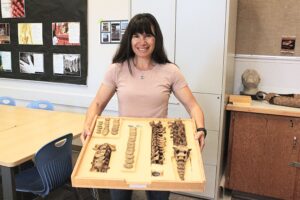Camosun Anthropology students recently had the chance to participate in an archaeological excavation of a black bear on campus.
After an Indigenous colleague gifted Anthropology professor Nicole Kilburn the carcass of a black bear in 2021, she took the first step to what would later become a hands-on learning opportunity for the students.
“When I was offered this unusual gift, I didn’t want to bury it in my backyard,” says Kilburn.
The bones needed some cleanup, and Kilburn thought that the Lansdowne campus would be the right place to let Mother Nature do her work. That situation turned out to be an opportunity for students down the road—by the winter 2024 semester, the buried bear was ready to be the subject of hands-on learning through a full excavation to reveal, lift, clean, and label the bones.

“There was a real adrenaline boost when we first uncovered those,” says Kilburn. “It was some of the rib bones coming up off the top.”
Katie Waterhouse’s Forensic Anthropology class worked together with Kilburn’s Archaeology class to evaluate the bones from a forensics perspective. From looking at the bones they could tell a variety of information, such as the fact that the bear was a juvenile, from the presence of many small, unfused pieces of bone.
“If somebody’s a really good tennis player, you will actually see that on their bones,” says Kilburn. “It’s almost like our bodies are tattooed with parts of our lived experience. And I find that really interesting, that our bones can tell our stories.”
The paws of the bear were kept for Indigenous ceremonial purposes, and the skull was beaded and turned into a gift for Camosun Indigenous Studies alumnus Eddy Charlie, a co-initiator of Orange Shirt Day Victoria. Current students and instructors from the Indigenous Studies program were integral to the excavation, celebrating the bear’s life and death through drumming and song.
“My colleagues in Indigenous Studies came and helped and we drummed for the bear,” says Kilburn. “[Indigenous Studies instructor] Sandee Mitchell decided, after talking to some of her mentors, that bringing out the Anishinaabe Bear Song a little bit early was appropriate because our bears are waking up earlier these days because of climate change.”
Kilburn says that seeing the bear through a different lens allowed her students to view it as more than just an object or a material piece of history, and says that that extends to the archaeological study of humans. It’s very important to her that her students learn with their hearts, not just their heads.
“In the history of archaeology, we have had a very material focus where we think about things, and when you focus on the material culture, you can forget about the humans,” she says.
Overall, the students were excited, and the experience took learning outside of the textbook in a way that they had never done before. Kilburn—who adds that the Anthropology department is actively working with the college on similar projects for the future—says that many students stayed after class hours because they were so engaged with the project.
“I think that we can get quite overwhelmed with how much work there is, and the pressures of just focusing on grades instead of remembering that we’re getting all these skills,” she says. “And one of those skills is getting excited about learning something new.”
